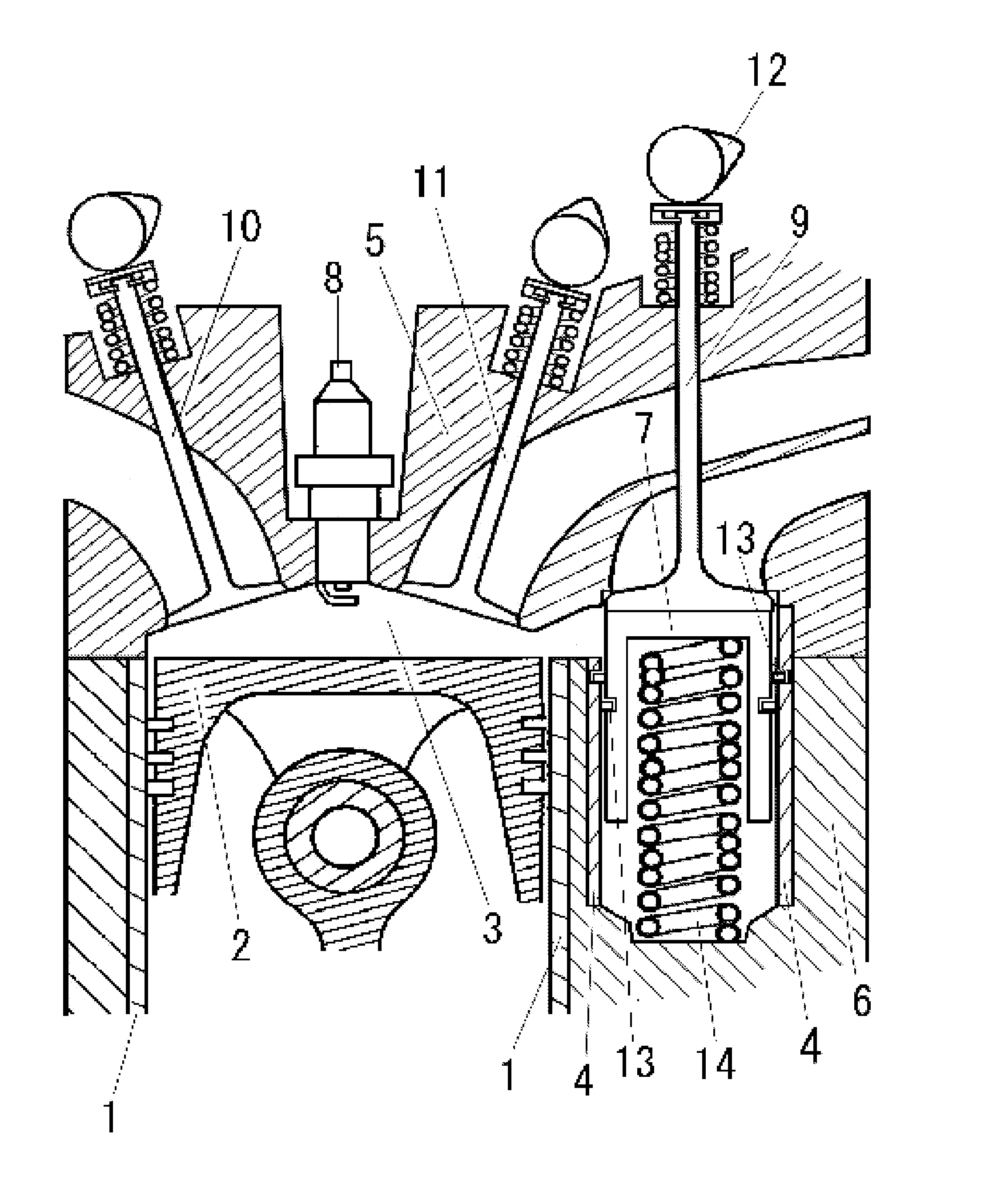Spark ignition four-stroke cycle engine
a four-stroke cycle engine and spark ignition technology, applied in the direction of engines, machines/engines, mechanical equipment, etc., can solve the problems of increasing the cooling loss amount, increasing the heat dissipation area, and deteriorating the fuel consumption, so as to increase the cooling loss
- Summary
- Abstract
- Description
- Claims
- Application Information
AI Technical Summary
Benefits of technology
Problems solved by technology
Method used
Image
Examples
first embodiment
[0044]A first embodiment is now described below.
[0045]A spark ignition four-stroke cycle engine illustrated in FIGS. 1 to 4 comprises a cylinder head 5, a cylinder block 6, a main cylinder 1, a piston 2, a combustion chamber 3, an ignition plug 8, a sub-cylinder 4, a valve cover 7, an intake poppet valve 11, a first exhaust poppet valve 10 and a second exhaust poppet valve 9.
[0046]The piston 2 has a groove for a piston ring and reciprocates within the main cylinder 1. The combustion chamber 3 is formed between the cylinder head 5 and the piston 2. Further, the combustion chamber 3 is expanded out of the main cylinder 1.
[0047]The exhaust popper valve 9 is provided on a wall surface of the combustion chamber 3 expanded out of the main cylinder 1. One or more second exhaust poppet valves 9 may be provided.
[0048]The valve cover 7 has a cylindrical outer peripheral surface. The valve cover 7 reciprocates within the sub-cylinder 4. In order to bring an upper surface of the valve cover 7 i...
second embodiment
[0070]A second embodiment is now described below.
[0071]Hereinafter, only the difference between the first embodiment and the second embodiment is described.
[0072]Another example of the valve opening time for the second exhaust poppet valve 9 and the first exhaust poppet valve 10 is described.
[0073]In order to further reduce the temperature of the bottom surface of the first exhaust poppet valve 10, the first exhaust poppet valve 10 is preferably opened at a crank angle larger than that for the second exhaust poppet valve 9. If the valve opening time for the first exhaust poppet valve 10 is set in this manner, the gas pressure within the main cylinder may be too high after reaching the bottom dead center. In this manner, after reaching the bottom dead center of the exhaust stroke, an amount of exhaust loss work is increased.
[0074]In fact, it is required to seek the optimal valve opening time for the first exhaust poppet 10, which prevents the amount of exhaust loss work from increasi...
third embodiment
[0079]The above problem can be solved by a third embodiment described below referring to FIG. 4.
[0080]In the third embodiment, the following configurations are added to the first and second embodiments.
[0081]In the third embodiment, the positional relationship between the first exhaust poppet valve 10 and the intake poppet valve 11 is limited. In other words, the first exhaust poppet valve 10 is provided between the intake poppet valve 11 and the second exhaust poppet valve 9. The intake poppet valve 11 is not adjacent to the second exhaust poppet valve 9.
[0082]The end of the valve opening period for the second exhaust poppet valve 9 overlaps with the start of the valve opening period for the intake poppet valve 11. The period during which the second exhaust poppet valve 9 and the intake poppet valve 11 overlaps with each other is around the top dead center of the exhaust stroke. In FIG. 4, the top dead center of the exhaust stroke is illustrated.
[0083]The valve closing time for the...
PUM
 Login to View More
Login to View More Abstract
Description
Claims
Application Information
 Login to View More
Login to View More - R&D
- Intellectual Property
- Life Sciences
- Materials
- Tech Scout
- Unparalleled Data Quality
- Higher Quality Content
- 60% Fewer Hallucinations
Browse by: Latest US Patents, China's latest patents, Technical Efficacy Thesaurus, Application Domain, Technology Topic, Popular Technical Reports.
© 2025 PatSnap. All rights reserved.Legal|Privacy policy|Modern Slavery Act Transparency Statement|Sitemap|About US| Contact US: help@patsnap.com



